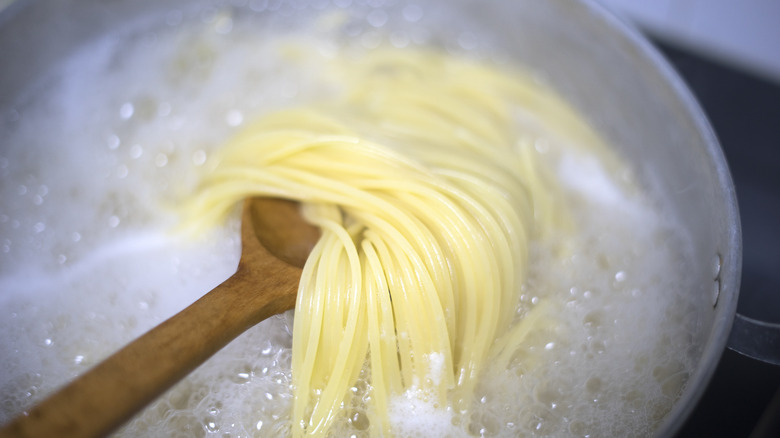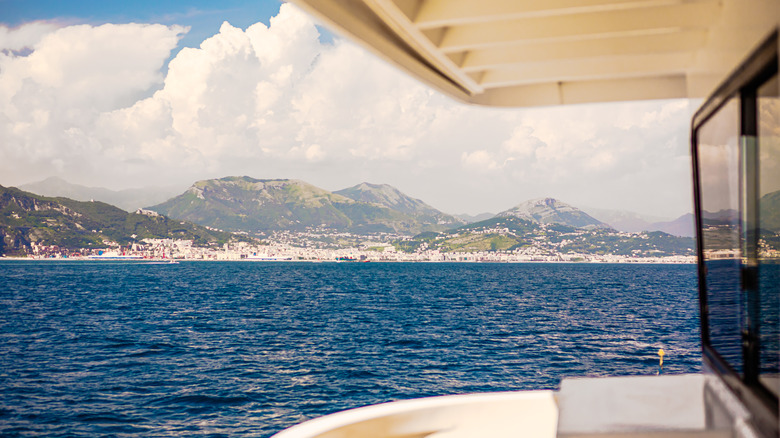Giada De Laurentiis' Secret Weapon For Boiling Pasta Is Italian Sea Water
Saltwater makes many things better — we all know it gives us good hair after a day at the beach, and nothing screams summertime like the scent of salt air. Famed chef, author, and TV personality Giada De Laurentiis clearly believes in the power of vitamin sea, scooping up a potful of actual seawater to cook her pasta in a recent video she shared on TikTok.
There are all sorts of tips you need to perfectly cook pasta, but this might be one you've yet to try. In the video, the chef is on a boat off the coast of Italy with her family "the dream," as she puts it) and is, unsurprisingly, in charge of dinner. She leans over the back of the boat to scoop up a pot full of water to boil pasta. Before dumping some out, she notes that she'll use half fresh water. Conventional cooking wisdom advises stopping short of salting your water to ocean levels of sodium, which is why De Laurentiis dumps out half the pot.
Of course, we all know by now to salt our pasta water. It's one of those steps that makes such an immediate difference versus cooking in a pot of plain water — once you've given it a go, there's no other way. The needed jolt of sodium imparts so much flavor into your spaghetti, penne, or lasagna noodles right out of the gate, setting your Italian dishes up for success.
Why using (part) ocean water makes sense
As important as it is to add salt to your water before cooking noodles, you'd be left with a puckered mouth if you cook your pasta — or anything — entirely in seawater. The salt level of the ocean is around 3.5% salinity, hence the advice to never salt your pasta water to the saltiness level of a mouthful of the ocean. You'll need to cut it with fresh water, As Giada De Laurentiis does, to get the correct amount of salt in your pasta water. For every 4 quarts of water, you should add 2 tablespoons of salt.
The benefit of using seawater — if you find yourself so lucky to be oceanside at dinner time — is the rich, complex flavor you'd never get from table salt. That's thanks to the diverse symphony of minerals and components unique to specific oceans, which means your noodles will pick up a rich depth of flavor unique to the area. In De Laurentiis' case, since she's cooking with water off the coast of Italy, the exact taste of that water and resulting pasta is likely different than water scooped from the Pacific Ocean, for example. No matter the source of your salt, be it the sink or the Mediterranean Sea, taking this step not only adds huge flavor to your noodles but improves texture too, making for less mushy noodles.
Is ocean water safe to cook with?
We're all picky about our water quality — and rightfully so. Whether you're drinking safe, clean tap water, taking the extra step to filter your house's water with contraptions like reverse osmosis or Brita pitchers, most of us would never dream out of drinking water from a lake or river. By that same logic, is it actually safe to eat food that's been cooked in water straight from the ocean with no filtration, as Giada De Laurentiis' video shows?
It's a very fair question, especially as depending which open you're pulling water from, you could also be scooping up all sorts of contaminants, motor oil, bacteria, not to mention the scary-as-they-sound "forever chemicals" in our water. In reality, cooking using seawater is fairly common in a variety of cultures the world over, but home cooks — especially landlocked ones — might find it a little bit shocking. Most advise that as long as you're not collecting water from a known polluted source, scooping up water as far offshore as possible, and bringing it to a full and rolling boil as you will be if cooking pasta, there's likely no cause for concern.
If you're unsure, a little icked out, or just don't have the good fortune of finding yourself cooking pasta on the open seas (relatable!), just grab your regular salt shaker and sprinkle away — your less exotic sodium source will still bring the flavor just fine.


